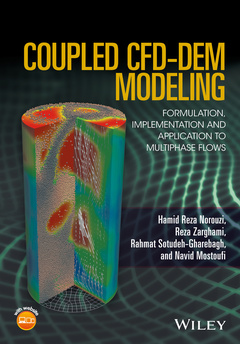Coupled CFD-DEM Modeling Formulation, Implementation and Application to Multiphase Flows
Auteurs : Norouzi Hamid Reza, Zarghami Reza, Sotudeh-Gharebagh Rahmat, Mostoufi Navid

Discusses the CFD-DEM method of modeling which combines both the Discrete Element Method and Computational Fluid Dynamics to simulate fluid-particle interactions.
- Deals with both theoretical and practical concepts of CFD-DEM, its numerical implementation accompanied by a hands-on numerical code in FORTRAN
- Gives examples of industrial applications
About the Authors xi
Preface xiii
1 Introduction 1
1.1 Multiphase Coupling 2
1.2 Modeling Approaches 2
1.3 Modeling with DEM 5
1.4 CFD‐DEM Modeling 7
1.5 Applications 10
1.6 Scope and Overall Plan 10
1.7 Online Content 12
References 12
Part I DEM 15
2 DEM Formulation 17
2.1 Hard‐Sphere 18
2.1.1 Equation of Motion 19
2.1.2 Collision Model 19
2.1.3 Interparticle Forces 22
2.2 Soft‐Sphere 24
2.2.1 Equations of Motion 25
2.3 Force‐Displacement Laws 27
2.3.1 Linear Viscoelastic Model 29
2.3.2 Nonlinear Viscoelastic Models 36
2.3.3 Comparison of Viscoelastic Force‐Displacement Models 45
2.3.4 Elastic Perfectly Plastic Models 49
2.4 Torque Expressions 56
2.4.1 Model A: Constant Torque Model 56
2.4.2 Model B: Viscous Model 57
2.4.3 Model C: Spring‐Dashpot Model 57
2.5 Boundary and Initial Conditions 58
2.5.1 Boundary Conditions 58
2.5.2 Initial Condition 60
Nomenclature 60
References 64
3 DEM Implementation 68
3.1 Computational View 68
3.2 Program Structure 71
3.3 Contact Search Algorithms 76
3.3.1 Definition of Problem 79
3.3.2 Cell‐Based Algorithms 80
3.3.3 Sort‐Based Algorithms 96
3.3.4 Tree‐Based Broad Search Algorithms 99
3.3.5 Fine Search for Spherical Particles 103
3.4 Integration Methods 103
3.4.1 Single‐Step Methods 106
3.4.2 Multi‐Step Algorithms 110
3.4.3 Predictor‐Corrector Methods 112
3.4.4 Evaluation of Integration Methods 114
3.5 Spring Stiffness 119
3.5.1 Maximum Overlap 122
3.5.2 Collision Time and Maximum Contact Force 123
3.6 Wall Implementation 123
3.6.1 Definition of Wall Elements 125
3.6.2 Contact Detection 128
3.6.3 Moving Wall 136
3.7 Parallelization 138
3.7.1 Distributed Memory Parallelization 138
3.7.2 Shared‐Memory Parallelization 141
Nomenclature 145
References 147
4 Non‐Spherical Particles 152
4.1 Shape Representation 153
4.2 Kinematics and Dynamics of a Rigid Body 156
4.2.1 Euler Angles and Transformation Matrix 157
4.2.2 Equations of Motion 159
4.2.3 Quaternions for Rigid Body Dynamics 163
4.3 Superellipsoids 164
4.3.1 Contact Forces 166
4.3.2 Effective Radius and Curvatures 169
4.3.3 Torque Calculations 173
4.3.4 Contact Detection 174
4.4 Multi‐Sphere Method 178
Nomenclature 184
References 186
5 DEM Applications to Granular Flows 189
5.1 Packing of Particles 189
5.1.1 Confined Packing 189
5.1.2 Pile Formation 192
5.1.3 Rigid and Flexible Fibers 194
5.2 Flow in Hoppers 196
5.2.1 Flow Patterns 197
5.2.2 Segregation 199
5.2.3 Discharge Rate 201
5.3 Solid Mixing 203
5.3.1 Mechanisms of Mixing and Segregation 203
5.3.2 Mixing Index 205
5.3.3 Rotating Drums 209
5.3.4 Tumbling Blenders 220
5.3.5 Shaft Batch Mixers 223
5.3.6 Continuous Mixers 229
5.4 Screw Conveying 234
5.4.1 Simulation of Screw Conveyor 237
5.4.2 Results of the Simulations 238
5.4.3 Literature 239
5.5 Film Coating 241
5.5.1 Phenomenological Models 243
5.5.2 Monte‐Carlo Method 244
Nomenclature 247
References 249
Part II CFD‐DEM 257
6 CFD‐DEM Formulation and Coupling 259
6.1 Multiphase Coupling 260
6.1.1 Coupling Strategies 260
6.1.2 Types of Coupling 262
6.1.3 Interphase Interactions 265
6.2 Momentum Coupling 267
6.2.1 Single Phase Flow of Fluids 267
6.2.2 Fluid Resolution in CFD‐DEM 274
6.2.3 Unresolved Surface CFD‐DEM 275
6.2.4 Surface Force Decomposition 287
6.3 Energy Coupling 303
6.3.1 Governing Equations 304
6.3.2 Rates of Heat Transfer for Particles 308
6.3.3 Rates of Heat Transfer for Fluid 316
6.3.4 Sequence of Calculations 317
6.4 Mass Coupling 319
6.4.1 Governing Equations 319
6.4.2 Rates of Mass Transfer for Particles 324
6.4.3 Rates of Change in Fluid 329
6.4.4 Sequence of Calculations 329
Nomenclature 329
References 335
7 CFD‐DEM Applications to Multiphase Flow 341
7.1 Fluidization 341
7.1.1 Macro‐Scale Phenomena 342
7.1.2 Meso‐Scale Phenomena 344
7.1.3 Micro‐Scale Phenomena 345
7.2 Spouting 347
7.3 Pneumatic Conveying 355
7.3.1 Dilute Phase and Dense Phase Conveying 356
7.3.2 Horizontal Conveying 357
7.3.3 Vertical Conveying 359
7.4 Non‐Isothermal Flows 359
7.5 Reactive Flows 362
7.6 Miscellaneous 364
Nomenclature 365
References 366
8 Interparticle Forces and External Fields 372
8.1 Governing Equations 373
8.1.1 Sequence of Calculations 375
8.2 Interparticle Forces 376
8.2.1 van der Waals Force 376
8.2.2 Liquid Bridge Force 379
8.2.3 Electrostatic Force 386
8.3 External Fields 390
8.3.1 Electric Field 390
8.3.2 Magnetic Field 393
8.3.3 Vibration Field 397
8.3.4 Acoustic Field 398
8.4 Applications 399
Nomenclature 404
References 407
Index 412
Hamid Reza Norouzi holds a PhD from the University of Tehran in chemical engineering. His research interests are discrete element modeling, computational fluid dynamics and multiphase flows in chemical and pharmaceutical processes.
Reza Zarghami is Head of the Pharmaceutical Engineering program and Assistant Professor at the School of Chemical Engineering at the University of Tehran. His research interests include pharmaceutical processing and manufacturing, powder technology, advanced fluid mechanics and CFD in chemical engineering, and he has published over 70 articles.
Rahmat Sotudeh-Gharebagh is Director of Standard Research Institute, ISIRI, Tehran, Iran and a Professor of Chemical Engineering, at the University of Tehran. He founded the Pharmaceutical Engineering program there. His research interests include fluidization engineering, process modeling and simulation, chemical engineering education, pharmaceutical engineering and information technology. He has published three books, over 230 articles, and serves as editor-in-chief of Chemical Product and Process Modeling, and Journal of Industrial Technology Development.
Navid Mostoufi is a Professor at the School of Chemical Engineering at the University of Tehran in Iran where he has taught for 14 years. His industry experience has included developing operator training simulators and feasibility studies for several companies. He is the author of more than 140 journal articles and 115 conference papers on process engineering and modeling, and is an editor for three journals including Chemical Product and Process Modeling where he is joint editor-in-chief with Professor Rahmat Sotudeh-Gharebagh.
Date de parution : 10-2016
Ouvrage de 432 p.
17.3x24.6 cm
